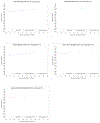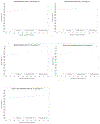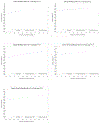Relative efficiency of equal versus unequal cluster sizes in cluster randomized trials with a small number of clusters
- PMID: 32970522
- PMCID: PMC8734433
- DOI: 10.1080/10543406.2020.1814795
Relative efficiency of equal versus unequal cluster sizes in cluster randomized trials with a small number of clusters
Abstract
To calculate sample sizes in cluster randomized trials (CRTs), the cluster sizes are usually assumed to be identical across all clusters for simplicity. However, equal cluster sizes are not guaranteed in practice, especially when the number of clusters is limited. Therefore, it is important to understand the relative efficiency (RE) of equal versus unequal cluster sizes when designing CRTs with a limited number of clusters. In this paper, we are interested in the RE of two bias-corrected sandwich estimators of the treatment effect in the Generalized Estimating Equation (GEE) models for CRTs with a small number of clusters. Specifically, we derive the RE of two bias-corrected sandwich estimators for binary, continuous, or count data in CRTs under the assumption of an exchangeable working correlation structure. We consider different scenarios of cluster size distributions and investigate RE performance through simulation studies. We conclude that the number of clusters could be increased by as much as 42% to compensate for efficiency loss due to unequal cluster sizes. Finally, we propose an algorithm of increasing the number of clusters when the coefficient of variation of cluster sizes is known and unknown.
Keywords: Bias-corrected sandwich estimator; cluster randomized trial (CRT); generalized estimating equation (GEE); intracluster correlation coefficient (ICC); relative efficiency (RE).
Conflict of interest statement
Conflict of Interest
The authors have declared no conflict of interest
Figures








Similar articles
-
Sample size calculation in three-level cluster randomized trials using generalized estimating equation models.Stat Med. 2020 Oct 30;39(24):3347-3372. doi: 10.1002/sim.8670. Epub 2020 Jul 28. Stat Med. 2020. PMID: 32720717 Free PMC article.
-
Methods for dealing with unequal cluster sizes in cluster randomized trials: A scoping review.PLoS One. 2021 Jul 29;16(7):e0255389. doi: 10.1371/journal.pone.0255389. eCollection 2021. PLoS One. 2021. PMID: 34324593 Free PMC article.
-
Relative efficiency of unequal versus equal cluster sizes in cluster randomized trials using generalized estimating equation models.Biom J. 2018 May;60(3):616-638. doi: 10.1002/bimj.201600262. Epub 2018 Mar 25. Biom J. 2018. PMID: 29577363 Free PMC article.
-
Small sample performance of bias-corrected sandwich estimators for cluster-randomized trials with binary outcomes.Stat Med. 2015 Jan 30;34(2):281-96. doi: 10.1002/sim.6344. Epub 2014 Oct 24. Stat Med. 2015. PMID: 25345738 Free PMC article.
-
Generalized estimating equations in cluster randomized trials with a small number of clusters: Review of practice and simulation study.Clin Trials. 2016 Aug;13(4):445-9. doi: 10.1177/1740774516643498. Epub 2016 Apr 19. Clin Trials. 2016. PMID: 27094487 Review.
Cited by
-
Sample size calculation in three-level cluster randomized trials using generalized estimating equation models.Stat Med. 2020 Oct 30;39(24):3347-3372. doi: 10.1002/sim.8670. Epub 2020 Jul 28. Stat Med. 2020. PMID: 32720717 Free PMC article.
-
Methods for dealing with unequal cluster sizes in cluster randomized trials: A scoping review.PLoS One. 2021 Jul 29;16(7):e0255389. doi: 10.1371/journal.pone.0255389. eCollection 2021. PLoS One. 2021. PMID: 34324593 Free PMC article.
-
15 Years of Longitudinal Genetic, Clinical, Cognitive, Imaging, and Biochemical Measures in DIAN.medRxiv [Preprint]. 2024 Aug 9:2024.08.08.24311689. doi: 10.1101/2024.08.08.24311689. medRxiv. 2024. PMID: 39148846 Free PMC article. Preprint.
References
-
- Austin P (2007). A comparison of the statistical power of different methods for the analysis of cluster randomization trials with binary outcomes. Statistics in Medicine 26:3550–3565. - PubMed
-
- Candel MJJM and Van Breukelen GJP (2010). Sample size adjustments for varying cluster sizes in cluster randomized trials with binary outcomes analyzed with second-order PQL mixed logistic regression. Statistics in Medicine 29(14):1488–1501. - PubMed
-
- Candel MJJM, Van Breukelen GJP, Kotova L and Berger MPF (2008). Optimality of Equal vs. Unequal Cluster Sizes in Multilevel Intervention Studies: A Monte Carlo Study for Small Sample Sizes. Communications in Statistics - Simulation and Computation 37(1):222–239.
-
- Donner A, Birkett N and Buck C (1981). Randomization by cluster-sample size requirements and analysis. American Journal of Epidemiology 114:906–914. - PubMed
Publication types
MeSH terms
Grants and funding
LinkOut - more resources
Full Text Sources
Research Materials
